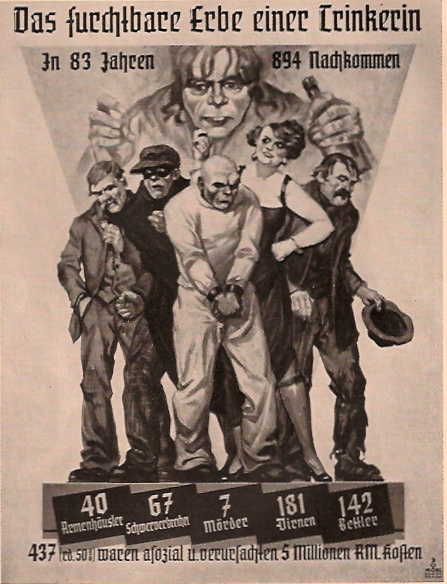Wir stehen nicht allein: “We do not stand alone”. Nazi poster from 1936 with flags of other countries with compulsory sterilization legislation
The image above of a mother nursing a child is from a 1936 Third Reich poster. The woman is holding a baby and the man is holding a shield inscribed with the title of Nazi Germany’s 1933 Law for the Prevention of Hereditarily Diseased Offspring. This was their compulsory sterilization law.
The couple are in front of a map of Germany, surrounded by the flags of nations which had enacted (to the left) or were considering (bottom and to the right) similar legislation.
The countries which had enacted compulsory sterilization laws were:
- United States (Indiana enacted first laws in 1907)
- Denmark (1929)
- Norway (1934)
- Sweden (1935)
- Finland (1935?)
- Hungary
- United Kingdom
- Switzerland
- Poland
- Japan
- Latvia
- Estonia
Hitler believed the nation had become weak, corrupted by the infusion of degenerate elements into its bloodstream. These had to be removed quickly.
He also believed that the strong and the racially pure should be encouraged to have more children, and that the weak and the racially impure should be neutralized by one means or another.
In organizing their eugenics program the Nazis were inspired by the United States' programs of forced sterilization, especially on the eugenics laws that had been enacted in California.
Those selected for Nazi sterilization included the feeble minded, criminals, homosexuals, the idle, the insane, the weak, degenerates and dissidents.
The title of the above poster is: “The terrible results of a woman drunkard.” It shows that over 83 years, she had 894 descendents, of whom 40 were destitute, 67 criminals, 7 murderers, 181 prostitutes, and 142 beggars. “437 (about 50%) were asocial, and caused 5 million Marks of harm.”
In Hitler's second book he argued that sterilization was much more humane (degenerates are burdened with illnesses) than the insanity of our day which takes the life of a hundred thousand healthy children in consequence of birth control or through abortions.
It was an Englishman, not a German, who first came up with the term eugenics in 1883. Sir Francis Galton was a cousin of Charles Darwin and he became obsessed with the Origin of Species, especially its chapter on the breeding of domestic animals. This inspired him to spend much of his life studying the variations in human ability. He wrote: "The question was then forced upon me. Could not the race of men be similarly improved? Could not the undesirables be got rid of and the desirables multiplied?".
Galton argued that early marriage between healthy, mentally strong families should be encouraged by financial incentives, and reproduction by the "feeble-minded" should be curtailed.
In 1958 the Eugenics Society, now the Galton Institute, issued warnings that the mingling of races that had started in Britain as a result of high immigration from the third world “ran counter to the great developing pattern of human evolution” and attacked the United Nations for minimizing the “quite obvious dissimilarities between people and individuals.” [1]
Galton's writings played a key role in launching the eugenics movement in the United States.
When he was Home Secretary (February 1910-October 1911) Winston Churchill was in favor of the confinement, segregation, and sterilization of the "feeble minded."
"The improvement of the British breed is my aim in life," Winston Churchill wrote to his cousin Ivor Guest on 19 January 1899, shortly after his twenty-fifth birthday.
As can be seen, Nazi Germany wasn't the only country to support sterilization. It was being done in other countries long before Hitler came to power.
References:
1. J. Procter, Writing Black Britain, 1948-1998: An Interdisciplinary Anthology (Manchester University Press, 2000)
Wikipedia
New Statesman




